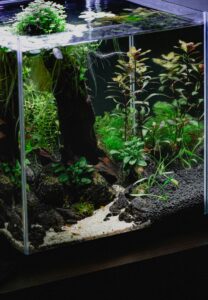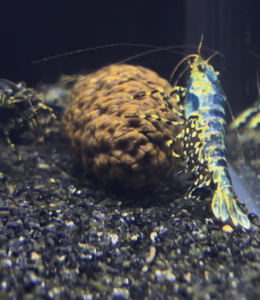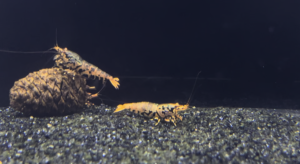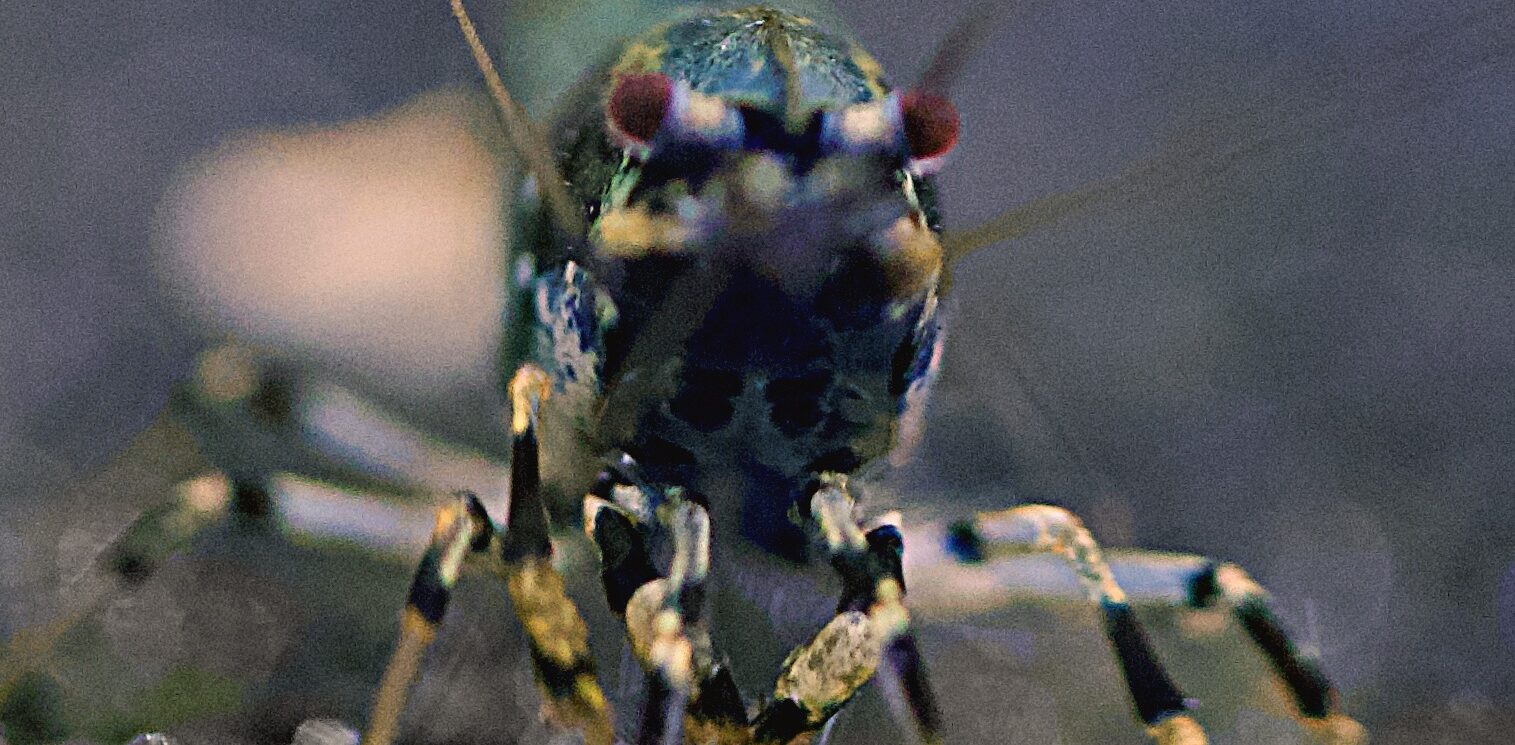 Brief description of Caridina Boa Shrimp appearance: Caridina Boa Shrimp are characterized by their elegant and intricate patterning, featuring a dark, almost black body with distinctive white stripes resembling a boa constrictor’s markings. This unique coloration sets them apart as a striking addition to planted aquariums.
Brief description of Caridina Boa Shrimp appearance: Caridina Boa Shrimp are characterized by their elegant and intricate patterning, featuring a dark, almost black body with distinctive white stripes resembling a boa constrictor’s markings. This unique coloration sets them apart as a striking addition to planted aquariums.
Scientific name and classification: Caridina Boa Shrimp belong to the genus Caridina within the family Atyidae.
Origin and natural habitat: The Boa Shrimp is a product of selective breeding from various Caridina species, primarily Caridina cantonensis. This species, native to streams and rivers in southeastern China and Taiwan, serves as the wild ancestor for many popular aquarium shrimp varieties.
The development of Boa Shrimp involved crossbreeding several selectively bred varieties, including:
- Crystal Red Shrimp (CRS)
- Crystal Black Shrimp (CBS)
- Taiwan Bee Shrimp
- Tiger Shrimp (not usually but depending on lineage)
These varieties were themselves the result of selective breeding from wild Caridina cantonensis populations. Breeders carefully selected and paired shrimp with desirable traits over multiple generations to achieve the distinctive “boa” pattern – characterized by bold, snake-like stripes that give the shrimp its name.
The creation of Boa Shrimp is an ongoing process, with breeders continuously refining the strain to enhance coloration, pattern definition, and overall aesthetics. As a result, Boa Shrimp exist exclusively in captivity and do not have a natural habitat in the wild.
Physical appearance, size, and lifespan: These shrimp typically grow to about 1.5 inches (3.8 cm) in length at maturity. Their lifespan in optimal aquarium conditions ranges from 1 to 2 years, influenced by environmental factors and care.

Caridina Boa Shrimp Care and Ideal Water Parameters
- TDS (Total Dissolved Solids): 100-120 ppm
- pH: 5.4-6.2
- GH (General Hardness): 4-5 dGH
- KH (Carbonate Hardness): 0-1 dKH
- Temperature: 60-72°F (15.5-22°C)
Setting Up a Successful Caridina Boa Shrimp Tank
Tank Size Recommendations
When setting up a tank for Caridina Boa Shrimp, starts at 10 gallons (38 liters), and a minimum of 5 gallons (19 liters)
is recommended. While they are small creatures, a larger tank provides more stable water parameters and a healthier environment, which is crucial for their delicate nature.
Filtration Options (Focus on Sponge Filters)
Sponge filters are highly recommended for Caridina Boa Shrimp tanks. They provide gentle filtration, which is crucial since strong currents can stress these small shrimp. Sponge filters also offer a surface for biofilm growth, an additional food source for shrimp. They effectively filter the water without posing a risk of sucking in tiny shrimp.
 Substrate Choices
Substrate Choices
Choosing the right substrate is essential for maintaining optimal water conditions. A substrate designed for shrimp or plants, like active soil substrates, can help maintain the slightly acidic pH that Caridina Boa Shrimp prefer. These substrates also provide a natural look and support the growth of beneficial bacteria.
Importance of Hiding Places and Plants
Hiding places and live plants are vital in a Caridina Boa Shrimp tank. Shrimp feel safer and exhibit more natural behaviors when they have plenty of hiding spots. Live plants like Java moss, Anubias, and ferns not only provide cover but also contribute to water quality by absorbing nitrates and providing surfaces for biofilm growth. Adding driftwood and shrimp-specific decorations can also create additional hiding spaces.
Acclimation Process
Proper acclimation is critical to reduce stress and increase the survival rate of newly introduced shrimp. The drip acclimation method is recommended, where shrimp are slowly introduced to the new tank water over a period of 1-2 hours. This gradual process helps them adjust to the new water parameters and reduces the risk of shock.
For more detailed information on setting up and maintaining a healthy environment for Caridina Boa Shrimp, check out our Comprehensive Caridina Care Guide.
Diet and Feeding
Natural Feeding Habits
In the wild, Caridina Boa Shrimp are omnivores that feed on biofilm, algae, decaying plant matter, and small microorganisms. This varied diet is essential for their health and well-being.
Recommended Commercial Foods
High-quality commercial shrimp foods are formulated to meet the nutritional needs of Caridina Boa Shrimp. Look for products that include a mix of plant-based and protein-based ingredients. Brands like Shrimp King, Bacter AE, and Hikari offer pellets and powdered foods that are well-suited for these shrimp.
 Supplemental Foods (Vegetables, Leaves, etc.)
Supplemental Foods (Vegetables, Leaves, etc.)
In addition to commercial foods, supplement their diet with blanched vegetables like spinach, zucchini, and peas. Indian almond leaves and mulberry leaves are also excellent choices, as they decompose slowly and provide additional nutrients and biofilm. These supplements mimic their natural feeding habits and add variety to their diet.
Feeding Frequency and Amount
Feed 2-3 times a week, an amount that the shrimp can consume within 1-2 hours. Avoid overfeeding to maintain water quality and prevent food from fouling the tank.
Understanding Caridina Boa Shrimp Grading
Basic Principles of Caridina Boa Shrimp Grading
Grading Caridina Boa Shrimp involves assessing their color, pattern, and overall appearance. Higher-grade shrimp exhibit more vibrant colors and distinct patterns. The grading system helps breeders and hobbyists distinguish between different quality levels of shrimp.
Key features to look for:
- Back pattern: A thick, wavy line running along the shrimp’s back, differing from the thinner, more defined “fishbone” pattern of other varieties.
- Body coloration: A base of golden to bluish metallic hues, often with a striking sheen.
- Head pattern: Distinctive spots or markings on the head, varying in size and coverage.
- Spider legs: Legs with a pattern that appears to extend from the body, often with contrasting colors.
- Body spots: Presence of spots on the body, particularly on the tail and sides.
- Overall pigmentation: The intensity and coverage of coloration across the shrimp’s body.
Importance of Grading in Breeding and Sales
Grading is crucial for breeders aiming to improve their stock and for sellers to price their shrimp appropriately. High-grade shrimp are often more desirable and fetch higher prices in the market. Consistent grading standards help maintain the quality and appeal of Caridina Boa Shrimp in the hobby.
Color Grading
Description of Different Color Grades
S Grade (Standard)
1. Characteristics
– Basic Boa shrimp features are present but may not be fully developed
– Back pattern is visible but may be thinner or less defined
– Coloration shows some metallic sheen but may be less intense
– Head pattern and body spots are present but may be sparse
– Spider leg pattern is visible but may not extend fully
SS Grade (High)
1. Characteristics
– Well-defined back pattern with good thickness and waviness
– Stronger metallic sheen with more consistent coverage
– Clear head pattern with a good balance of spots
– More pronounced spider leg pattern extending to most legs
– Better overall harmony of features
SSS Grade (Premium)
1. Characteristics
– Excellent back pattern with ideal thickness and waviness
– Strong, vibrant metallic coloration covering the entire body
– Rich, well-balanced head pattern with ideal spot distribution
– Full spider leg pattern on all legs
– High level of overall harmony and visual appeal
Factors Affecting Color Intensity
Several factors influence the color intensity of Caridina Boa Shrimp, including:
- Genetics: The most significant factor, that shrimp with superior genetic backgrounds exhibit more vibrant colors.
- Diet: A diet rich in carotenoids and other color-enhancing nutrients helps maintain and enhance color intensity.
- Water Quality: Stable, optimal water parameters prevent stress, which can dull shrimp colors. High-quality water promotes better overall health and coloration.
- Lighting: Proper lighting enhances the visibility of shrimp colors. However, too much direct light can cause algae growth, which needs to be balanced.
Breeding Caridina Boa Shrimp
Breeding Setup Requirements
Setting up a breeding tank for Caridina Boa Shrimp involves ensuring optimal conditions for successful mating and raising shrimplets. Key requirements include:
- Tank Size: A dedicated breeding tank of at least 10 gallons.
- Water Parameters: Stable parameters within the ideal range (pH 5.4-6.2, TDS 100-120, GH 4-5, KH 0-1, temperature 60-72°F).
- Filtration: Sponge filters to ensure gentle water flow and safe habitat for shrimplets.
- Substrate: A fine substrate like shrimp-specific soil to maintain appropriate pH and provide a surface for biofilm growth.
- Hiding Places: Ample plants, mosses, and decorations for shelter and security.
Mating Behavior
Caridina Boa Shrimp exhibit specific mating behaviors, typically initiated by the female releasing pheromones into the water. Males will actively swim around the tank searching for the female. Once found, mating occurs quickly, and the female will carry fertilized eggs beneath her abdomen.
Egg Development and Hatching
After mating, the female carries the eggs for about 30 days, fanning them regularly to ensure they receive adequate oxygen. The eggs gradually change color, from a bright yellow or green to a darker hue as they develop.
Care for Shrimplets
Once hatched, shrimplets are tiny and vulnerable. They require stable water conditions and a diet of biofilm and finely powdered shrimp food. Ensuring plenty of hiding places and minimal disturbances in the tank will help increase their survival rate. Regular but gentle water changes and avoiding the use of chemicals are essential to maintaining a healthy environment for the growing shrimplets.

Common Health Issues and Treatments
Signs of Stress or Illness
Caridina Boa Shrimp, like all shrimp, can show several signs when they are stressed or ill. Common indicators include:
- Lethargy or reduced activity
- Loss of color or fading patterns
- Clamped antennae or appendages
- Abnormal swimming behavior, such as erratic or rapid movements
- Lack of appetite or reduced feeding
- Visible parasites or unusual spots on the body
Common Diseases and Parasites
Some of the common diseases and parasites affecting Caridina Boa Shrimp include:
- Bacterial Infections: Often manifest as white or cloudy patches on the shrimp’s body. Symptoms include lethargy and loss of appetite.
- Fungal Infections: Visible as cotton-like growths on the body or appendages.
- Parasitic Infections: Vorticella and Scutariella japonica are common parasites that appear as white tufts on the shrimp.
- Molting Issues: Difficulty molting can be caused by poor water quality or inadequate nutrition. Shrimp may get stuck in their old shell or exhibit incomplete molts.
Prevention and Treatment Options
- Prevention: Maintain optimal water parameters, perform regular water changes, provide a balanced diet, and avoid overcrowding. Quarantine new shrimp before introducing them to the main tank.
- Bacterial Infections: Treat with antibacterial medications specifically designed for shrimp, such as those containing kanamycin or furan-2. Ensure proper aeration and water quality during treatment.
- Fungal Infections: Use antifungal treatments suitable for shrimp, like methylene blue or copper-free medications.
- Parasitic Infections: Salt baths can be effective, or use antiparasitic medications like fenbendazole at safe dosages.
- Molting Issues: Improve water quality, ensure a balanced diet rich in calcium, and consider adding minerals to the water if necessary.
Compatible Tank Mates
Suitable Shrimp Species
Caridina Boa Shrimp can be kept with other peaceful shrimp species that share similar water parameter requirements, such as:
- Crystal Red Shrimp (Caridina cantonensis)
- Crystal Black Shrimp (Caridina cantonensis)
- Tiger Shrimp (Caridina mariae)
- Bee Shrimp (Caridina cantonensis)
Compatible Fish Species
While it is generally best to keep Caridina Boa Shrimp in species-only tanks to avoid stress and predation, some small, peaceful fish can coexist with them, including:
- Otocinclus Catfish
- Corydoras Catfish (especially pygmy varieties)
- Small rasboras, such as Chili Rasboras (Boraras brigittae)
- Microdevario Kubotai
*No fish are not recommended in a breeding colony.
Species to Avoid
Avoid housing Caridina Boa Shrimp with larger or aggressive fish species that may prey on them, such as:
- Cichlids
- Angelfish
- Betta Fish
- Any large or territorial fish species
FAQs
Can Caridina Boa Shrimp be kept with Crystal Red Shrimp?
Yes, Caridina Boa Shrimp can be kept with Crystal Red Shrimp as they have similar care requirements and water parameter preferences. However, crossbreeding can occur, which may affect the purity of specific lines if you are breeding them.
Can Caridina Boa Shrimp be kept with fish?
Caridina Boa Shrimp can be kept with small, peaceful fish species that do not view them as food. Avoid larger or predatory fish to prevent stress and predation on the shrimp.
*No fish are not recommended in a breeding colony
How long do Caridina Boa Shrimp live?
Caridina Boa Shrimp typically live for 1.5 to 2 years under optimal conditions. Providing a stable environment and proper nutrition can help maximize their lifespan.
How often do Caridina Boa Shrimp molt?
Caridina Boa Shrimp molt approximately every 4 to 6 weeks, depending on their growth stage and environmental conditions. Frequent molting is common in younger shrimp as they grow, while adults molt less frequently.
What causes Caridina Boa Shrimp to lose color?
Several factors can cause Caridina Boa Shrimp to lose color, including stress, poor water quality, inadequate diet, and illness. Ensuring stable water parameters, providing a balanced diet, and minimizing stress can help maintain their vibrant colors.
Buying Guide
How to Spot Healthy Shrimp
When purchasing Caridina Boa Shrimp, look for the following signs of good health:
- Active Behavior: Healthy shrimp are active and constantly foraging for food.
- Bright Colors: Vibrant and consistent coloration indicates good health. Avoid shrimp with dull or faded colors.
- Clear Eyes and Body: Look for clear, transparent areas without cloudy spots or visible parasites.
- Intact Appendages: Ensure all legs, antennae, and other appendages are intact and functional.
- Normal Swimming Patterns: Healthy shrimp swim smoothly and do not exhibit erratic or distressed behavior.
Selecting the Best Specimens
To select the best Caridina Boa Shrimp, consider:
- Grade and Pattern: Choose shrimp with higher grades and well-defined patterns if aesthetics and breeding are your priorities.
- Size and Age: Opt for juvenile or young adult shrimp, as they adapt better to new environments and have longer reproductive potential.
- Consistency: Select shrimp that display consistent coloration and patterns, especially if you plan to breed them.
Reputable Sources for Purchasing Caridina Boa Shrimp
To ensure you get healthy and high-quality Caridina Boa Shrimp, purchase from:
- Specialized Breeders: Reputable breeders often provide detailed lineage and health information. Look for well-established lineages. Starting a breeding colony with purebred or near purebred lineages is essential for consistent offspring and predictable gene inheritance, untainted by other variant genes.
- Aquarium Stores: Look for stores with a good reputation for shrimp care and knowledgeable staff.
- Online Vendors: Trusted online vendors and shrimp-specific websites can be good sources. Check reviews and ratings before purchasing.
Boa Shrimp
Shipping Considerations
When ordering shrimp online, consider:
- Weather Conditions: Avoid extreme temperatures during shipping. Choose express shipping to minimize transit time.
- Packaging: Ensure the vendor uses proper packaging with insulated boxes, heat or cold packs as needed, and ample padding.
- Acclimation: Follow the acclimation instructions provided by the vendor carefully to reduce stress on the shrimp upon arrival.
Advanced Caridina Boa Shrimp Keeping
Selective Breeding Techniques
To selectively breed Caridina Boa Shrimp:
- Identify Traits: Determine which traits (color, pattern, size) you want to enhance.
- Separate Breeding Tanks: Use dedicated breeding tanks to control and monitor mating.
- Selective Pairing: Pair shrimp that exhibit the desired traits. Track lineage to maintain genetic diversity.
- Culling: Remove shrimp that do not meet breeding standards to maintain quality.
Creating Unique Color Morphs
Creating unique color morphs involves:
- Crossbreeding: Cross different high-quality strains to produce new color variations.
- Line Breeding: Intensify specific traits over generations by breeding offspring back to parent lines.
- Experimentation: Be patient and document results meticulously to understand which pairings yield desirable outcomes.
Participating in Shrimp Competitions
To compete in shrimp shows:
- Research Competitions: Find local or international shrimp competitions and understand their rules and categories.
- Prepare Your Shrimp: Select your best specimens, ensuring they are in peak health and display optimal traits.
- Presentation: Use high-quality photos or transport shrimp safely to the competition venue.
- Engage with the Community: Networking with other breeders and hobbyists can provide valuable insights and opportunities.
Recap of Caridina Boa Shrimp Appeal and Care Requirements
Caridina Boa Shrimp are a captivating addition to any aquarium, known for their striking colors and intricate patterns. Their care requires attention to water quality, diet, and habitat setup. Despite their delicate nature, the rewards of keeping and breeding these beautiful shrimp are immense.
Encouragement for Readers to Try Keeping Caridina Boa Shrimp
If you’re looking to add a unique and vibrant touch to your aquarium, consider Caridina Boa Shrimp. Their fascinating behaviors and beautiful appearance can bring joy and a sense of achievement to any aquarist. With proper care and attention, you’ll find these shrimp to be a delightful and rewarding challenge. Dive into the world of Caridina Boa Shrimp keeping, and experience the satisfaction of nurturing these exquisite creatures.










